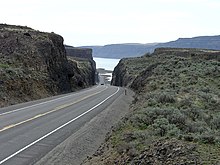
In civil engineering, a cut or cutting is where soil or rock from a relative rise is removed.
Cuts are typically used in road, rail, and canal construction to reduce a route's length and grade. Cut and fill construction uses the spoils from cuts to fill in defiles to create straight routes at steady grades cost-effectively.
Cuts are used as alternatives to indirect routes, embankments, or viaducts. They also have the advantage of comparatively lower noise pollution than elevated or at-grade solutions.
In river management, the term cut or cutting is also used, which refers to the action of short-cutting a meander, in order to speed a waterway's flow.
History

The term cutting appears in the 19th century literature to designate rock cuts developed to moderate grades of railway lines. Railway Age's Comprehensive Railroad Dictionary defines a cut as "a passage cut for the roadway through an obstacle of rock or dirt."
Creation

Cuts can be created by multiple passes of a shovel, grader, scraper or excavator, or by blasting. One unusual means of creating a cut is to remove the roof of a tunnel through daylighting. Material removed from cuts is ideally balanced by material needed for fills along the same route, but this is not always the case when cut material is unsuitable for use as fill.
The word is also used in the same sense in mining, in particular Open-pit mining. The use of cuttings often provides byproducts as a form of mineral extraction, commonly sand, clay or gravel; the cost of building drains, reinforcing banks against landslide and a high water table are factors which commonly limit its use in certain areas.
Types of cut
There are at least two types of cut, sidehill cut and through cut. The former permits passage of a transportation route alongside of, or around a hill, where the slope is transverse to the roadway or the railway. A sidehill cut can be formed by means of sidecasting, i.e., cutting on the high side balanced by moving the material to build up the low side to achieve a flat surface for the route. In contrast, through cuts, where the adjacent grade is higher on both sides of the route, require removal of material from the area since it cannot be dumped alongside the route.
A ledge is a cut in the side of a cliff well above the bottom of a gorge.
Lock cut

A lock cut is a section of a river or other inland waterway immediately upstream and downstream of a lock which has been modified to provide locations for boats to moor while waiting for the lock gates to open or to allow people to board or alight vessels.
Notable cuts
Canal
- Culebra Cut (Gaillard Cut) on the Panama Canal
- Dawesville Cut
- Corinth Canal
Rail
Asia
Americas
Australia
Europe

- Olive Mount cutting, Liverpool, England
- Talerddig cutting, Wales
Road
See also
- Cut-and-cover
- Dashrath Manjhi
- Embankment (transportation)
- Flying arch, use of a dummy arch bridge to stabilise cutting walls against landslip (landslide)
- Trench
References
- Alexander Smith (1875) A new history of Aberdeenshire
- Robert G. Lewis et al., eds., Railway Age's Comprehensive Railroad Dictionary (Omaha, Neb.: Simmons-Boardman Books, 1984), p. 48. That reference does not include a definition for the corresponding term "fill."
- Herbert L. Nichols, Jr., and David A. Day, P.E., Moving the Earth: The Workbook of Excavation, 5th ed. (New York: McGraw-Hill, 2005), pp. 8.16 et seq.
- Nichols and Day, Moving the Earth, p. 8.16.
| Geotechnical engineering | |||||||
|---|---|---|---|---|---|---|---|
| Offshore geotechnical engineering | |||||||
| Investigation and instrumentation | |||||||
| Soil |
| ||||||
| Structures (Interaction) |
| ||||||
| Mechanics |
| ||||||
| Numerical analysis software | |||||||
| Related fields | |||||||